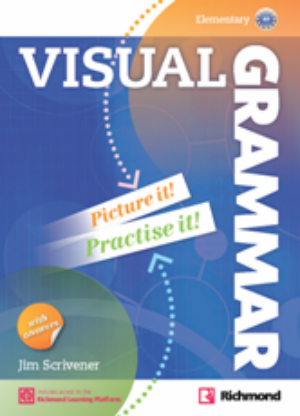A book I've used - Visual Grammar: Picture it! Practice it!
Visual Grammar: Picture it! Practise it!
(Pre-Intermediate)
Jim Scrivener
Richmond 2014
 This book really lives up to its name! It’s like learning from a picture book. Every page has pictures and colours showing how the grammar works so that just looking at it is a pleasure. Aimed at teenagers and young adults, it can be used by students working on their own (using the ‘with key’ version) or as a class book with a teacher (using the ‘without key’ version).
This book really lives up to its name! It’s like learning from a picture book. Every page has pictures and colours showing how the grammar works so that just looking at it is a pleasure. Aimed at teenagers and young adults, it can be used by students working on their own (using the ‘with key’ version) or as a class book with a teacher (using the ‘without key’ version).
The two-page units (98 of them) are short and the grammar is learned in manageable chunks. The practice sections are contained within real-life contexts and the online section offers extra free practice. Teachers can use the Richmond Learning Platform to track and assign activities for their students as well as create customised online tests.
The pictures have the aim of both helping the student understand the meaning of the grammar as well as remember it. They are supported by grammar boxes with easy to understand explanations of the rules and examples of use in real-life speaking situations. There are also timelines and diagrams, for example showing the differences between extremely big, really big, etc. down to extremely small.
Of course there are lots of practice exercises: some exercises ask questions about the student’s life, friends, ideas and other things that he or she knows or does. Others require the use of the internet to find the answer. In some units there are freer exercises such as ‘word pools’, which the students use to make sentences.
I like the second unit focusing on SVO sentence structure, in which 3D pictures are used above a table showing word order: a red triangle for the subject, a yellow circle for the verb, a blue box for the direct object and a purple box for the indirect object. The images made a great impact on my students and helped them remember the ‘concept’.
The third unit introduces adjectives while the fourth teaches adjective order. In a logical progression, the next units teach degrees of size, extremes and quantities. By the middle of the book, tense is introduced and time lines are used in the diagrams. These time lines look more interesting than most because they have people sitting on them with red dotted lines showing contrasts, such as decision and action or plan and action when talking about the future!
But this book is so good, it’s difficult to pick favourite units. The pictures are absolutely amazing. For example, the unit about talking about things that will possibly happen is based on a cartoon strip about Agent ZK202 who might find a spy whose name might be Hiram at a nightclub. Of course, in the end, the agent gets her spy.
Another fabulous unit is the one which practises saying that you feel the same as someone else. This unit has three pictures of scenes in Venice. One picture is a street scene with short conversations such as I don’t like crowds followed by Neither do I Another is that of a couple on a gondolier saying I think this is romantic and So do I, and a third is of a café with My sister was at last year’s carnival with So was I. As elsewhere, explanation and practice are on the facing page.
The final unit in the book is about understanding young people’s colloquial conversations – and he goes ... and I was like ... I’m so gonna – and gives a warning about using English like this in an exam, and stresses that the other units in this book are based on standard ‘educated’ English used in schools and colleges, etc.
I used this book with my adult class, most of whom are young adults, and like me, they loved the colourful pictures, the short conversations and the manageable chunks of grammar learning.
Glenda Inverarity currently teaches English to migrants and refugees in the Adult Migrant English Program (AMEP) at English Language Services in Adelaide, Australia.
Comments
Write a Comment
Comment Submitted